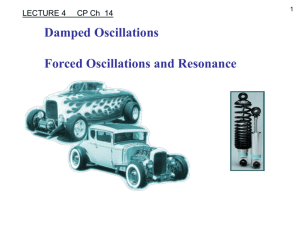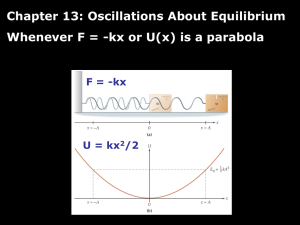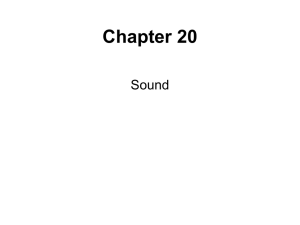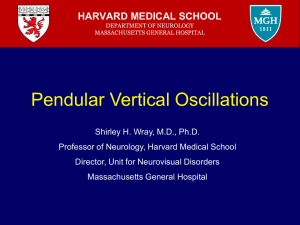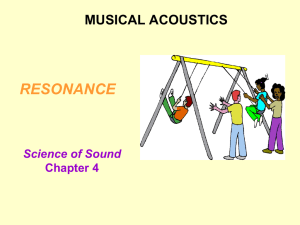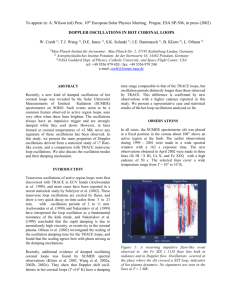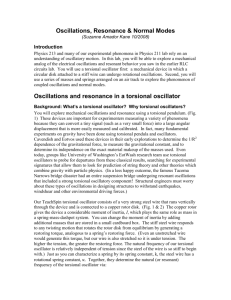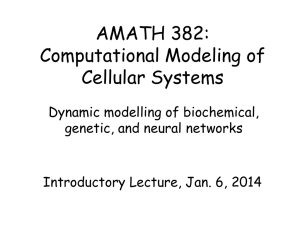oscillations_03
advertisement
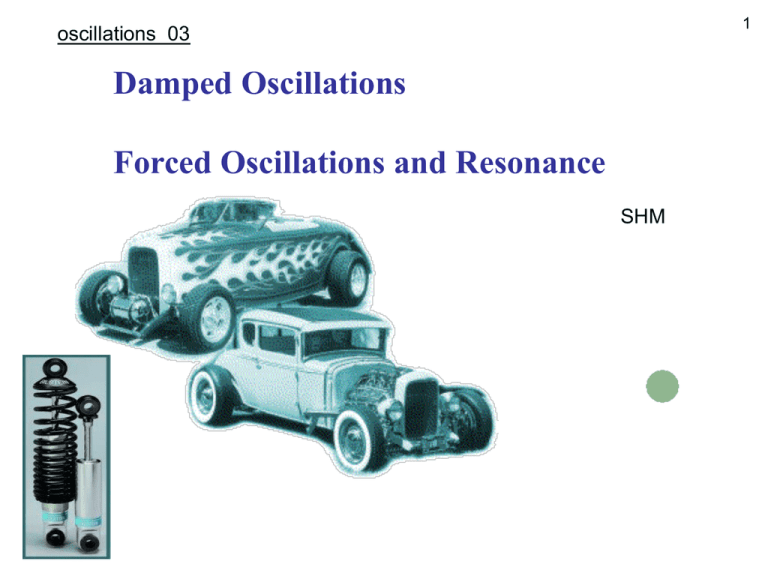
1 oscillations_03 Damped Oscillations Forced Oscillations and Resonance SHM Review: SHM 2 mass/spring system x xmax cos t v xmax sin t a xmax 2 cos t a 2 x 2 2 f T k 2 m 1 2 1 2 PE k x k xmax cos2 t 2 2 1 1 1 2 2 2 2 2 KE m v m xmax sin t k xmax sin 2 t 2 2 2 Etotal KE PE 1 2 1 2 k xmax m vmax = constant 2 2 1 1 2 1 2 2 m v k x k xmax 2 2 2 2 v xmax x2 CP 445 3 SHM position x 10 0 -10 0 10 20 30 40 50 60 70 80 90 100 0 10 20 30 40 50 60 70 80 90 100 0 10 20 30 40 50 time t 60 70 80 90 100 velocity v 5 0 acceleration a -5 1 0 -1 CP445 energy K Ue E (J) velocity v (m/s) extension y (m) SHM (zero damping) 10 0 -10 0 2 4 6 8 10 12 2 4 6 8 10 12 2 4 6 time t (s) 8 10 12 20 0 -20 0 6000 4000 2000 0 0 5 b=0 0.12 E energy K U E (J) 0.1 0.08 KE PE 0.06 0.04 0.02 0 0 2 4 time t (s) 6 8 CP 455 6 oscillations_03: MINDMAP SUMMARY Reference frame, restoring force, damping force, driving force (harmonic driving force), net (resultant) force, Newton’s Second Law, natural frequency of vibration, free oscillations, damping (underdamped, critical damping, overdamped), exponential decay, graphical interpretation of damping, forced oscillations, resonance, driving frequency, resonance curve, self-excited oscillations, examples of resonant phenomena, strategy for answering examination questions, ISEE f 1 2 k m 7 Mathematical modelling for harmonic motion Newton’s Second Law can be applied to the oscillating system F = restoring force + damping force + driving force F(t) = - k x(t) - b v(t) + Fd(t) For a harmonic driving force at a single frequency Fd(t) = Fmaxcos( t + ). This differential equation can be solved to give x(t), v(t) and a(t). CP 463 8 Damped Oscillations Oscillations in real systems die away (the amplitude steadily decreases) over time - the oscillations are said to be damped For example: The amplitude of a pendulum will decrease over time due to air resistance If the oscillating object was in water, the greater resistance would mean the oscillations damp much quicker. CP 463 9 Damped Oscillations CP 463 10 b=6 0.12 energy K U E (J) 0.1 E 0.08 PE 0.06 0.04 0.02 KE 0 0 2 4 time t (s) 6 8 CP 463 11 10 10 8 8 6 6 4 4 extension y (m) extension y (m) The graphs show the vertical motion of an object attached to the end of a spring. Describe the motion of the object. Up is the positive direction. 2 0 -2 2 0 -2 -4 -4 -6 -6 -8 -8 -10 -15 -10 -5 0 velocity v (m/s) 5 10 15 -10 -15 -10 -5 0 velocity v (m/s) 5 10 15 12 Forced oscillations Driven Oscillations & Resonance If we displace a mass suspended by a spring from equilibrium and let it go it oscillates at its natural frequency 1 f 2 k m If a periodic force at another frequency is applied, the oscillation will be forced to occur at the applied frequency - forced oscillations CP 465 13 Resonance Forced oscillations are small unless the driving frequency is close to the natural frequency When the driving frequency is equal to the natural frequency the oscillations can be large - this is called resonance Away from resonance, energy transfer to the oscillations is inefficient. At resonance there is efficient energy transfer which can cause the oscillating system to fail - see wine glass experiment. Famous example of resonance: soldiers marching on bridge CP 465 14 Resonance phenomena occur widely in natural and in technological applications: Emission & absorption of light Lasers Tuning of radio and television sets Mobile phones Microwave communications Machine, building and bridge design Musical instruments Medicine nuclear magnetic resonance (magnetic resonance imaging) x-rays hearing Nuclear magnetic resonance scan CP 465 Response Curve b is the damping factor 15 0.4 amplitude A (m) 0.35 b=2 0.3 0.25 0.2 0.15 b=8 0.1 0.05 0 b = 10 0 0.5 1 1.5 fd d/ f/ o o 2 2.5 3 CP 465 16 Sinusoidal driving force fd / fo = 0.1 Sinusoidal driving force fd / fo = 1 b=2 b=2 1 0.5 position x (m) position x (m) 1 0 -0.5 -1 0 20 40 60 time t (s) 80 100 0.5 0 -0.5 -1 0 20 40 60 time t (s) 80 100 CP 465 17 Impulsive force – constant force applied for a short time interval. Sinusoidal driving force fd / fo = 2 b=2 1 1 0.5 0.5 position x (m) position x (m) b=2 0 -0.5 -1 0 20 40 60 time t (s) 80 100 0 -0.5 -1 0 20 40 60 time t (s) 80 100 CP 465 18 Forced vibrations - resonance fD = 0.4 fo fD = 1.1 fo fD = 1.6 fo Animation courtesy of Dr. Dan Russell, Kettering University 19 An optical technique called interferometry reveals the oscillations of a wine glass Great Links to visit http://www.acoustics.salford.ac.uk/feschools/waves/wine3video.htm http://www.acoustics.salford.ac.uk/feschools/waves/shm3.htm 20 Resonance and Hearing Cochlea staples Basilar membrane Eardrum Auditory canal vibrations of small bones of the middle ear vibration of eardrum due to sound waves 1 fo 2 k m Inner air – basilar membrane – as the distance increases from the staples, membrane becomes wider and less stiff – resonance frequency of sensitive hair cells on membrane decreases staples 3000 Hz 30 Hz CP467 21 Self excited oscillations Sometimes apparently steady forces can cause large oscillations at the natural frequency Examples singing wine glasses (stick-slip friction) Tacoma Narrows bridge (wind eddies) CP 466 22 CP 466 23 What is a good strategy for answering examination questions ??? 1 2 Read and answer the question Type of problem Identify the physics – what model can be used? 24 Use exam formula sheet 3 Answer in point form Break the question into small parts, do step by step showing all working and calculations (if can’t get a number in early part of a question, use a “dummy” number. Explicit physics principles (justification, explanation) Annotated diagrams (collect and information & data – implicit + explicit Equations Identify Setup Execute Evaluate Problem 1 Why do some tall building collapse during an earthquake ? 25 26 ISEE Vibration motion can be resolved into vertical and horizontal motions 27 Vertical motion natural frequency of vibration m 1 fo 2 k k m driving frequency fd 0.4 Resonance fd fo amplitude A (m) 0.35 b=2 0.3 0.25 0.2 0.15 b=8 0.1 0.05 b = 10 large amplitude oscillations – building collapses 0 0 0.5 1 1.5 d / o 2 2.5 3 28 Horizontal Motion Resonance Standing Waves setup in building antinodes 2nd floor Driver frequency fd nodes 2nd floor disappeared – driving frequency matches natural frequency (3rd harmonic) 29 antinode at top of building node antinode this floor will collapse node at ground level ground vibrates horizontally setting up a standing wave 30 Problem 2 Consider a tractor driving across a field that has undulations at regular intervals. The distance between the bumps is about 4.2 m. Because of safety reasons, the tractor does not have a suspension system but the driver’s seat is attached to a spring to absorb some of the shock as the tractor moves over rough ground. Assume the spring constant to be 2.0104 N.m-1 and the mass of the seat to be 50 kg and the mass of the driver, 70 kg. The tractor is driven at 30 km.h-1 over the undulations. Will an accident occur? 31 Solution 2 ISEE m = (50 + 70) kg = 120 kg k = 2x104 N.m-1 v = 30 km.h-1 Dx = 4.2 m Tractor speed v = Dx / Dt = 30 km.h-1 = (30)(1000) / (3600) m.s-1 = 8.3 m.s-1 The time interval between hitting the bumps (Dx = 4.2 m) Dt = Dx / v = (4.2 / 8.3) s = 0.51 s Therefore, the frequency at which the tractor hits the bumps and energy is supplied to the oscillating system of spring-seat-person f = 1 / Dt = 1 / 0.51 = 2.0 Hz. The natural frequency of vibration of the spring-seat-person is 1 f 2 k 1 m 2 2 104 2.1 Hz 120 This is an example of forced harmonic motion. Since the driving frequency (due to hitting the bumps) is very close to the natural frequency of the spring-seatperson the result will be large amplitude oscillations of the person and which may lead to an unfortunate accident. If the speed of the tractor is reduced, the driving frequency will not match the natural frequency and the amplitude of the vibration will be much reduced. 32
